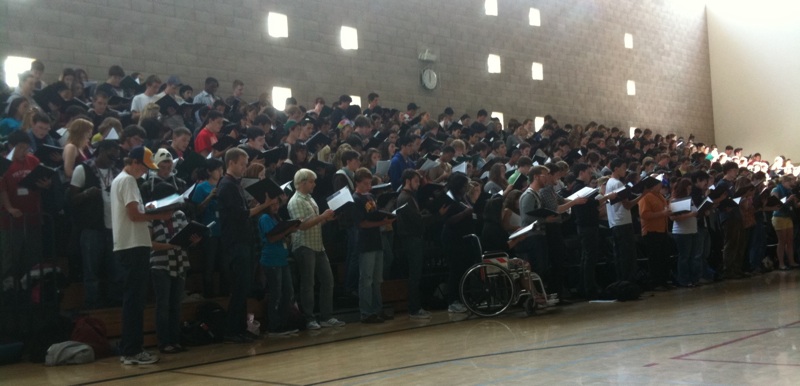Preparing the next generation
The Bay Area’s beloved Chanticleer, a vocal powerhouse and National Treasure, proved their mettle with their ambitious new educational program. Inviting 12 choirs from across the country, including the Piedmont High School A Cappella Choir, they held four days of intensive workshops that culminated in a joint concert at Davies Symphony Hall.
The concert was a thing of swooning beauty. But the heart lay in the grit of the workshops.

On Sunday, March 28, I watched their morning workshop in the concrete block gymnasium of San Francisco’s French American School. Streaming in from the courtyard, 416 young singers made their way to long bleachers, breaking up vocal types and choruses for mixed seating in order to better blend with the other vocal parts and hold their own line.
Matthew Oltman, Chanticleer’s artistic director, read a Walt Whitman poem, a prayer and invocation that heated the blood and condensed their focus. Indeed much of what they practiced was focus and professionalism.
Starting off with “Shenandoah,” a signature Chanticleer piece, Oltman worked through each phrase, training them as if each of the 416 singers was a new addition to the 12-singer ensemble. The other professionals sat mixed in, occasionally calling out suggestions or pitch problems. Their opening notes were pitch perfect, so clean a sound that the echoing gymnasium held no muddiness. They closed quickly to that first “n,” holding a vocal hum that brought a buzz to one’s back teeth.
“Is our last note with vibrato or straight tone?” asked one.
“Neither,” Oltman replied. “I want something without much undulation, but spinning.” And he demonstrated the extremes, a thick operatic vibrato and a slack-jawed sine wave. Then he gave the pure tone some motion and there was a living sound that could be shaped.
They spent some time with the basses on vowels, clarifying the opening “Shea” of Shenandoah into a brighter “Sheh,” and as they did, the pitch suddenly resolved. They then moved on to Chinese vowels, a sudden reminder of the high professional standards of the training—and of the difficulties of English diphthongs!
They practiced “Chou Nu Er” by Yi-Wen Chang, the winner of Chanticleer’s 2009 Student Composer Competition, working the difficult 7-beat rhythms and the pronunciation of “chiang”—not jiang, xiang or tsiang—and then explored the emotions of the poetry, an autumnal shift to resolve and resignation.
After, they sang in Latin, a language high school choruses are well versed in. Their remarkable clarity and attention to harmonies evoked an outburst of praise from the demanding Oltman.
The culmination
The following night at Davies was all one could have wished for. Their program started with that Latin piece, the psalm Jubilate Deo. They displayed their youthful ear for pitch and language, tuning to the singers around them. Their last long-held chord was breathtaking.
Ave Verum opened on pianissimo, 416 voices gently disturbing the air, then swelled before a final “Miserere,” which was again soft and shivery. It was ancient and compelling.
Chou Nu Er had its World premiere, complex rhythms fitting the brief syllables, unusual for voice and very effective. If voices could be plucked rather than bowed it could sound like this.
The other surprise was Annonciation (1951), by French composer Jean-Yves Daniel-Lesur on text by Loys Masson. Not only was this the US premiere of the work, but also Frederica von Stade, a veteran of the Metropolitan Opera and a local luminary, narrated the spoken text. This line-up induced Daniel-Lesur’s son, Christopher, to come from France for the occasion, and he gave moving remarks about his father before the piece. “He would have been elated…He never began music. He simply continued.”
A chamber orchestra was assembled for the piece. French horns opened with a clean, cool sound, unwavering despite their softness. The chorus entered with a difficult octave jump, and celesta and harp vied for sweet plucked tones. It was moody and very French, with simple phrases distressed by odd harmonies, and reminded one of Messiaen.
The showstopper, of course, was Chanticleer itself, who returned for two of their favorites. They evoked a Chinese village at dawn with sparrow song, whippoorwill and “Fung!” of temple bells. And then brought down the house with a doo-wop version of Gershwin’s Summertime, featuring countertenor Cortez Mitchell. His last long-held high note was answered by the screams of 400 students, and perhaps more than a few of the audience.
Von Stade returned to solo in the Shenandoah I’d heard rehearsed, her rich voice sparkling through their clean notes. The students’ hard preparation and complete focus was readily apparent in the magic of their delivery.
Oltman asked the 12 choir directors to come up on stage and join the singers for the final song, Ave Maria by Franz Biebl. I recognized Joe Piazza, one of the jewels in Piedmont High School’s crown, as he climbed into the stands. A well-loved and brilliant choral director, he has been a guiding force behind Piedmont’s vocal excellence, along with Robert Geary, whose Piedmont Choirs have helped shape our younger singers for 25 years.
The 23-member honor choir alternated phrases with the full chorus, line and clarity trading with a gentle susurrus of harmonies. Their large leaps and held sevenths drew to quiet resolutions, a moving end to this event.
—Adam Broner
Originally published in the Piedmont Post.
Photo of high school choirs in gymnasium of SF French American School; photo by A. Broner.
